Odontamblyopus rebecca is a species of eel goby native to marine and brackish waters of Vietnam. This species can reach a length of 14.1 centimetres (5.6 in) SL. This species is mostly known from several specimens collected from a fish market in Haiphong, Vietnam. The specific name honours Edward O. Murdy's wife Rebecca Rootes.

Chelmonops is a small genus of ray-finned fish, butterflyfishes from the family Chaetodontidae. Unlike the mainly tropical distribution of most marine butterflyfishes, Chelmonops is restricted to temperate and subtropical coastal waters along the southern half of Australia.
Lentipes whittenorum is a species of goby endemic to marine, brackish and fresh waters of Indonesia. The specific name jointly honours the biologists Anthony (Tony) and Jane Whitten, who assisted the describer Kottelat in a number projects in Indonesia, particularly in the survey of Bali, an island on which this goby occurs.
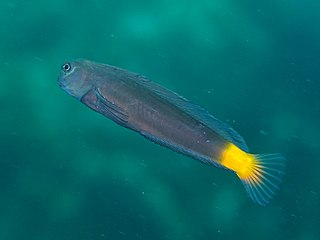
Ecsenius namiyei, commonly called black comb-tooth blenny or Namiye's coralblenny, is a species of marine fish in the family Blenniidae. The specific name honours the Japanese zoologist and museum curator Motoyoshi Namiye (1854-1915).

The giant mudskipper is a species of mudskipper native to the tropical shores of the eastern Indian Ocean and the western Pacific Ocean where it occurs in marine, brackish and fresh waters. It is most frequently found along muddy shores in estuaries as well as in the tidal zones of rivers. It lives in a burrow in the mud and emerges from the burrow at low tide on sunny days. It can move quickly across a muddy surface and is capable of breathing both in and out of water. The giant mudskipper can grow to a length of 27 centimetres (11 in) TL. This species is of minor importance to local commercial fisheries. The specific name honours the Dutch physician and naturalist Johann Albert Schlosser (1733-1769), who was a friend of Peter Simon Pallas and who received the type from the East Indies and sent it to Pallas.
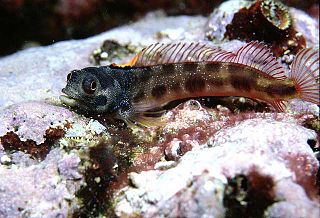
The Cortez barnacle blenny is a species of chaenopsid blenny found in the Gulf of California, in the eastern Pacific ocean. Males can reach a maximum length of 5.1 cm (2.0 in) SL, while females can reach a maximum length of 4 cm (1.6 in). The specific name honours the marine biologist Philip A. Hastings of the Scripps Institution of Oceanography.
Clinus helenae, the Helen's klipfish, is a species of clinid that occurs in subtropical waters of the Atlantic Ocean around South Africa where it is a denizen of tide pools. This species can reach a maximum length of 10 centimetres (3.9 in) TL. The identity of the person honoured in the matronym in this species' specific name is thought to be J.L.B. Smith's mother-in-law Helen Evelyn Zondagh (1877-1951).
Ophiclinus gabrieli, the Frosted snake-blenny, is a species of clinid native to Amphibolis seagrass in the coastal waters of southern Australia. It can reach a maximum length of 16 centimetres (6.3 in) TL. The specific name honours the Australian pharmacist and conchologist Charles John Gabriel (1879-1963), the collector of the type.
Labrisomus xanti, the Largemouth blenny, is a species of labrisomid blenny native to the Pacific coast of Mexico from Sebastián Vizcaíno Bay, Baja California to Bahía Tenacatita, Jalisco. It inhabits shallow waters. This species can reach a length of 17.8 centimetres (7.0 in) TL. The specific name honours the collector of the type, the Hungarian zoologist John Xantus (1825-1894).
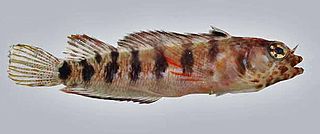
Starksia smithvanizi, the brokenbar blenny, is a species of labrisomid blenny native to the Caribbean Sea. It is found on reefs around islands at depths of from very shallow waters to 6 m (20 ft). This species can reach a length of 2 cm (0.79 in) SL. The specific name honours the ichthyologist William F. Smith-Vaniz.
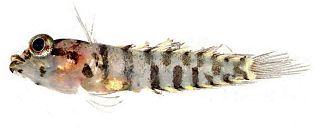
Starksia starcki, the key blenny, is a species of labrisomid blenny native to the Caribbean Sea. It inhabits coral reefs, preferring surge channels at depths of from 6 to 19 m. This species can reach a length of 4 cm (1.6 in) TL. It is also found in the aquarium trade. The specific name honours the Walter A Starck II in recognition of his contributions to marine biology.
Gobius senegambiensis is a species of marine fish from the family Gobiidae, the true gobies. It is native to the Atlantic Ocean from Morocco to Angola as well as the islands in the Gulf of Guinea. It is found in inshore waters on sandy bottoms. This species can reach a length of 7.3 centimetres (2.9 in) SL.
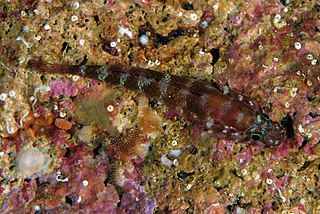
Steinitz's goby is a species of goby. It is native to the Mediterranean Sea near Marseilles. Recently recorded in the Adriatic Sea in Croatia, Tyrrhenian Sea in Italy, and in the Black Sea in Ukraine. This species can be found in underwater grottoes in inshore waters at depths of from 2 to 15 metres. It can reach a length of 3.8 centimetres (1.5 in) SL. The specific name honours the marine biologist and herpetologist Heinz Steinitz (1909-1971) of the Hebrew University, Jerusalem.
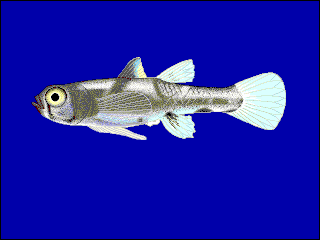
Pandaka is a genus of fish in the goby subfamily, Gobionellinae, native to fresh, brackish and marine waters of Asia and the western Pacific Ocean. Some species in the genus are among the smallest fish in the world; the male P. pygmaea can be just 9 mm (0.35 in) in standard length at maturity.
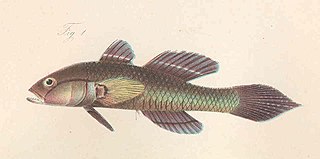
Porogobius schlegelii is a species of goby native to brackish and fresh waters along the Atlantic coast of Africa from Senegal to the Democratic Republic of the Congo. It is also found in the islands of the Gulf of Guinea and Cape Verde. It occurs in inshore waters in lagoons, estuaries, the lower reaches of rivers and mangrove swamps. This species grows to a length of 14.9 centimetres (5.9 in) TL. This species is the only known member of its genus. The specific name honours the ichthyologist Hermann Schlegel (1804-1884) who supplied Günther with the type specimen from the Natural History Museum in Leiden.
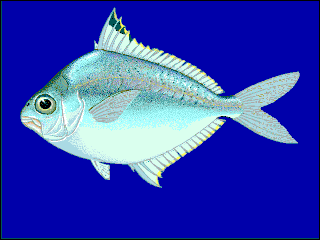
Eubleekeria is a genus of marine ray-finned fishes, ponyfishes from the family Leiognathidae which are native to the Indian Ocean and the western Pacific Ocean.

Eubleekeria jonesi, commonly known as Jones’ pony fish, is a marine rat-finned fish, a ponyfish from the family Leiognathidae. It is native to the Indian Ocean. This species was first formally described as Leiognathus jonesi in 1971 by the Indian ichthyologist P.S.B.R. James (1934-2019) and its specific name honours James’ predecessor as director of the Indian Central Marine Fisheries Institute in Kochi, Santhappan Jones (1910-1997).
Equulites klunzingeri, or Klunzinger's ponyfish, is a marine, demersal species of ponyfish from the family Leiognathidae which was originally found only in the Red Sea. It is colonizing the Mediterranean as part of the Lessepsian migration through the Suez Canal.
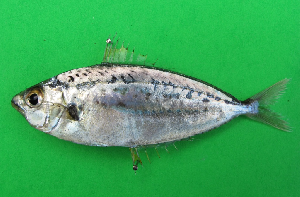
Equulites popei, Pope's ponyfish, is a species of marine ray-finned fish, a ponyfish from the family Leiognathidae. It has a wide Indo-Pacific distribution which extends from the Red Sea east to the western Pacific Ocean. It has entered the Mediterranean as a Lessepsian migrant. It was formerly considered to be synonymous with the elongate ponyfish.

Karalla dussumieri, Dussumier's ponyfish, is a species of marine ray-finned fish, a ponyfish from the family Leiognathidae. It is found in the Indo-Pacific region where it occurs from Madagascar and Réunion east to the Philippines. It is found in schools over substrates consisting of coral sand in coastal waters, although it will also enters estuaries. It feeds on small crustaceans, polychaetes, bivalves, foraminiferans, gastropods and nematodes. This species was first formally described as Equula dussumieri in 1835 by Achille Valenciennes with the type locality given as the Coromandel coast. The specific name honours the French voyager and merchant Jean-Jacques Dussumier (1792-1883), who collected the type.













